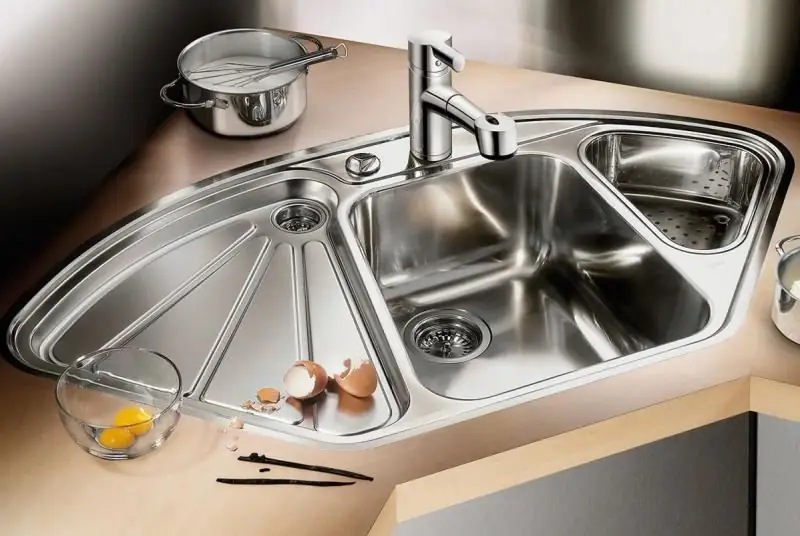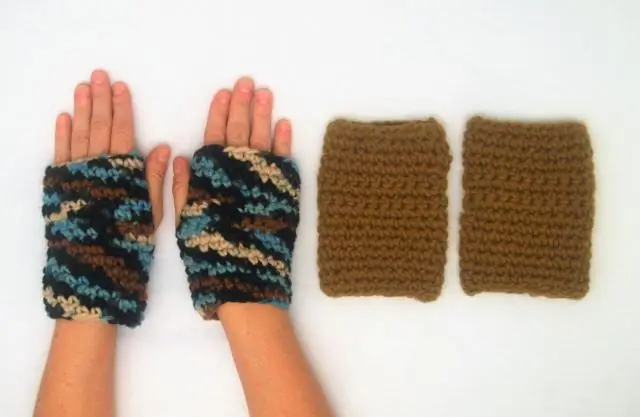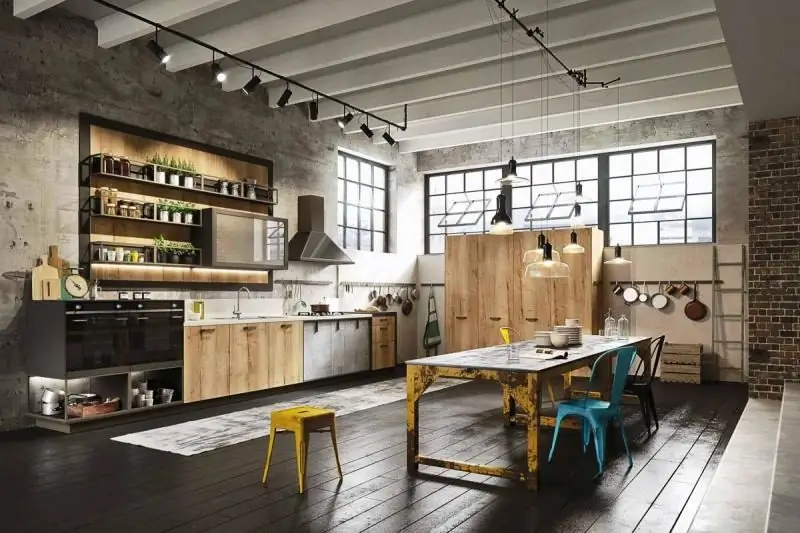
Table of contents:
- Author Bailey Albertson [email protected].
- Public 2024-01-17 22:26.
- Last modified 2025-06-01 07:32.
Corner sink for the kitchen: what you need to know when choosing it

The corner kitchen sink is a non-standard trapezoidal structure, not just a regular sink located in the corner of the room. But the expediency of their use is not always justified, therefore this issue requires close study.
Content
- 1 Corner sinks: positive and negative sides
-
2 Variety of shapes and sizes of corner sinks
2.1 Video: varieties of corner kitchen sinks
-
3 Materials from which corner sinks are made
3.1 Video: what are they made of and what are the kitchen sinks
- 4 Furniture for corner sinks
- 5 Installation methods for corner sinks
-
6 A few tips for choosing corner sinks
- 6.1 Video: choosing a sink for the kitchen
- 6.2 Photo gallery: kitchen design with a corner sink
Corner sinks: positive and negative sides
It cannot be said with certainty that corner sinks are appropriate in any kitchen. There are a number of points to consider when choosing a kitchen sink.
Corner sinks have undeniable advantages:
-
taking up space in the corner of the kitchen, they free up space on the work surface both on the right and left. The length of the edges of the working triangle (refrigerator-stove-sink) becomes optimal, excluding unnecessary movements;

Working triangle When placing the sink in the corner, the edges of the working triangle become optimal
-
a large corner cabinet, above which a sink is installed, allows you to place a large number of necessary fixtures and accessories inside:
- filtration system for water purification;
- disposer (waste shredder);
- water heater;
- system of containers for waste collection;
-
large kitchen utensils, etc.

Waste collection system Large corner cabinet can accommodate many useful gadgets, including a kitchen waste collection system
- a huge selection of models, different styles and sizes, with more interesting functionality than ordinary sinks;
- the corner sink is very convenient to use, since you do not need to bend or stretch to the side;
- such corner structures look much more harmonious and aesthetic.
Some significant disadvantages are an obstacle to using such sinks:
- corner sinks are large enough, so they are not suitable for kitchens with a small area;
- higher price;
-
in the case of a cut-in in a plastic-coated countertop, two joints remain, through which moisture can penetrate during operation and cause the base to swell. In addition, dirt accumulates at the joints;

Tabletop joints When joining plastic countertops, two very noticeable joints are obtained
- the cost of a corner piece of a kitchen countertop is significantly higher than simple straight parts;
- only one person can comfortably sit near the corner sink.

On the countertop made of artificial stone, the joints are almost invisible
Having worked with custom-made kitchen sets for more than 10 years, I can conclude that corner sinks do not stand up comfortably and correctly so often, even in large kitchens. The question often rests on finances, because the sinks and furniture themselves will cost more. Most often, the lower kitchen cabinets are joined at right angles and a regular straight sink is used. But corner sinks always look more interesting and modern. In addition, as a rule, they are equipped with many useful and convenient devices (colander, cutting boards, etc.).
Variety of shapes and sizes of corner sinks
Various shapes of sinks can be installed in the corner of the kitchen unit:
-
round or oval;

Round sink A regular round sink is installed in the corner
-
rectangular or square;

Rectangular sink In the corner of the kitchen unit, you can install an ordinary rectangular sink
-
trapezoidal.

Trapezoidal sink For corner sections, it is better to use special trapezoidal corner sinks
Strictly speaking, only trapezoidal shells are considered angular. The bowls in them can be round or rectangular, sometimes even triangular, or other more complex geometry. The number of bowls varies from one to five. Two-bowl corner sinks are popular, in one of the containers they pre-soak dishes, defrost meat, etc.

The number of bowls in the sink may vary
Sinks equipped with practically flat surfaces (wings), on which washed dishes, herbs, fruits, etc. are placed, are very convenient. It is recommended to keep sponges and brushes, as well as detergents in a shallow additional bowl located at the mixer.

The corner sink can have "wings" for drying dishes, vegetables, etc.
Apart from the overall size and shape, sinks differ in the depth of the bowls. The most convenient and optimal are shells with a depth of about 20-22 cm.
Video: varieties of corner kitchen sinks
Materials from which corner sinks are made
Modern industry offers corner sinks made of the following materials:
- stainless steel. The most popular, affordable and budget material with high temperature resistance, resistance to aggressive environments, durability, practicality, ease of maintenance and hygiene. Disadvantages include a tendency to scratch and noise generated by a falling jet of water. They are made of sheet steel of various thicknesses (from 0.5 to 1 mm, sometimes more). Can be matte, glossy (polished) and decorated (with a simple pattern);
-
composite materials. The so-called artificial stone (fragranite, silgranite, etc.), which is a durable composition of granite chips (up to 80%) and acrylic resins. Such sinks are practically silent during operation, they are not afraid of chemical, high-temperature and mechanical influences, they have a large number of colors. But cheap products with a low content of stone chips are capable of absorbing food coloring (juice of beets, grapes, etc.), and are also unstable in relation to high temperatures and scratches;

Composite sinks Composite sinks are available in a variety of colors
-
ceramics. Ceramic sinks (made from special types of refractory clay with additives and plasticizers) are the most environmentally friendly, durable, quiet and heat-resistant. They are scratch-free and very easy to care for. A significant disadvantage is increased fragility, considerable weight, some difficulties during installation and a tendency to form microcracks and chips. In addition, their high cost limits their wide distribution.

Ceramic sink Ceramic corner sinks are the most expensive
Our kitchen set has a good sink made of silgranite by the German company Blanco, we have been using it for several years. This composite material is imperceptible to splashes and streaks from water, so the sink always looks neat.
Video: what are they made of and what are the kitchen sinks
Furniture for corner sinks
Furniture cabinets for sinks with corner placement are manufactured in several versions:
-
with a beveled door. The lower pedestal has a characteristic pentagonal shape with a bevel in front, the facade is located at an angle of 45 °. The overwhelming majority of corner sinks are designed specifically for such furniture structures;

Angled corner sink cabinet Most often used are corner cabinets with one facade located at an angle of 45 °
-
with a radius door. The cabinet also has a pentagonal shape, but in front is not a bevel, but an internal rounding;

Radial door in the corner Radius corner doors look very original
-
with two straight doors. The curbstone has a 90 ° cutout on the front. The doors are connected with special fittings that allow them to fold like an accordion when opened. In their simplest form, they open independently of each other.

Folding doors It is possible to produce a corner section with a right angle and folding doors
Installation methods for corner sinks
According to the method of installation, corner kitchen sinks are divided into the following groups:
-
waybills. To install an overhead sink, no special skills and abilities are required. The product is simply placed on top of an appropriately sized corner cabinet and secured with the supplied fasteners. In this version, a corner countertop is not needed, the sink is installed directly on the furniture;

Overhead sink The overhead sink is a separate module that is installed directly on the cabinet
-
mortise. The most common way of installing kitchen sinks. A hole is cut out in the countertop according to a template (attached to the sink), then the sink is inserted into it and fixed from below with special fasteners to the edges of the countertop. All cuts are carefully treated with a sealant or varnish;

Flush sink The inset sink is installed in a hole cut in the worktop
-
integrable. With this method, the sink is mounted under the countertop. It is extremely difficult to perform such work at home, since special equipment is required. The gluing and installation of such sinks is carried out in production.

Integrated sink Integrated sink mounted under the countertop
A few tips for choosing corner sinks
When choosing a kitchen sink with an angular orientation, the following important points must be considered:
-
frequency and intensity of use. If there is a lot and often cook in the house, then you should opt for the largest possible sink, perhaps even a two-bowl one;

Two-bowl corner sink A sink with two deep bowls is suitable when there is a lot of cooking in the house.
-
the presence of a dishwasher. This kitchen unit eliminates the need to wash large batches of dishes, so it is quite possible to get by with a small and compact sink;

Kitchen with dishwasher If the headset has a dishwasher, then choosing a large corner sink is not necessary
-
kitchen design. The color and texture of the sink should be in harmony with the overall design. For example, in a classic style kitchen sinks made of artificial stone or ceramics are more appropriate. Shiny stainless steel is more often used in modern;

Classic headset For classic kitchen sets, they usually match the sink in the color of the countertop.
-
mixer design. For a kitchen tap with a low spout, you must choose a sink with a deep bowl, otherwise large dishes (pots) will not fit under it, and the spray will fly in different directions. If the mixer is tall or there is a retractable shower head (hose), then this is not necessary.

Mixer with pull-out spout If a mixer tap with a pull-out spout is intended, then a deep sink is not needed
Video: choosing a sink for the kitchen
Photo gallery: kitchen design with a corner sink
-

Corner sink at the bar - The corner sink can be located not in the corner of the room, but next to the bar counter
-

Contrast corner sink - Corner sinks in a contrasting color with the countertop look very impressive
-

Radial curbstone by the window - You can glue two rectangular sinks of different sizes under the countertop in the corner
-

Double sink by the window - A large corner cabinet can accommodate a regular two-bowl sink
-

Glued sink by the window - The option with a corner sink by the window always looks original
-

Sink with corner configuration at the bar - If the corner sink is located at the bar. then the hostess will face her guests
-

Corner pedestal with podium - Sometimes a special podium is mounted behind the corner sink, where you can keep various kitchen tools
-

Sink in the corner with a window - The integrated sink can be already two-bowl
-

Round sink in the corner of the kitchen - A round sink in the corner of the kitchen is the simplest and most common option.
-

Corner version with podium - On the podium behind the corner sink, you can place decorative ornaments (vases, figurines, etc.)
-

Corner sink made of stainless steel by the window - Polished stainless steel sink looks luxurious
-

Flush-mounted corner sink with two bowls - There are mortise corner sinks under the pedestals with a straight front joint in the corner
-

Oval sink in the corner - A small oval sink with a small wing can be installed in the corner
-

Corner module - Corner modules can be made from artificial stone along with the tabletop
-

Corner sink and dining table - The corner sink doesn't have to be in the corner of the room
-

Artificial stone corner sink - Unusual exclusive corner sinks are made of acrylic stone
-

Integrated sink with fenders - Along the integrated sink in the acrylic stone worktop, you can cut fenders with grooves to drain water
A corner kitchen sink can be extremely convenient and comfortable. But the choice must be approached with all responsibility, it is necessary to take into account a number of important factors and make an informed decision.
Recommended:
How To Stretch A Woolen Item If It Has Shrunk, What To Do To Restore Its Previous Shape And Size

The woolen thing has sat down: different ways to stretch it to restore its original appearance. How to properly care for wool clothing, keeping its shape. Video
How To Reduce Jeans By Size: Wash So That They Shrink, Return To Shape, If The Fabric Is Stretched, Sew At Home

How to reduce the size of jeans. How to wash denim so that it shrinks. Other ways to shrink jeans
The Interior Of The Kitchen And Living Room In A Loft Style In An Apartment And A Country House: Examples Of Design Design, Choice Of Color And Material, Decoration, Photo

The main features of the loft style and how to decorate the kitchen in such a design. The choice of materials, colors and textures for finishing. Loft-style lighting and decor for the kitchen
What Size Should Be The Sink For The Kitchen

Are there standards for kitchen sink sizes and what are they? What is the difference between different types of inset sinks and how to choose the right dimensions
Corner Kitchen With A Bar In A Modern Interior: Design Features, Photo Ideas

Features of the design of a corner kitchen with a bar counter. Layout options, choice of colors and materials. Suitable styles
